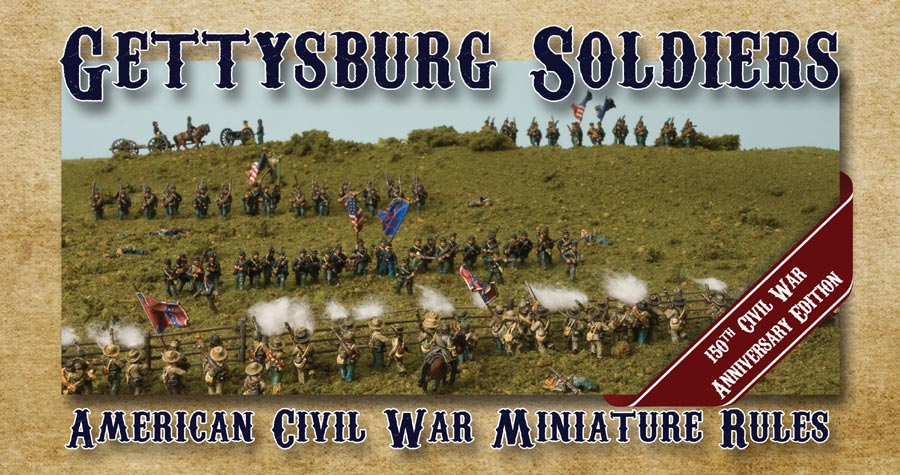|
|
|||||||||||||||||||||||||||||||||||
 |
|
The Rules Directory only works if you help. Write a review. Get the review template here. |
|
TITLE: Gettysburg Soldiers 150th Civil War Anniversary Edition AUTHOR: Larry Reber and Justin Reber PUBLISHER: Gettysburg Soldiers PUBLICATION DATE: 2011 WEB SITE/SUPPORT FORUM: Player support can be obtained on the Gettysburg Soldiers forum. PRICE (with date): $15.00 (in 2015) REVIEWED BY: Mark “Extra Crispy” Severin PERIOD COVERED: The American Civil War THE BOOK: Gettysburg Soldiers is a slim booklet, printed in full color with a metal coil binding. It is small as well - about 5” tall and 11” wide. The book runs a mere 22 pages, including a spread of the charts necessary for play taking up two of them. The rules are written in brief bullet points each of which is numbered for easy reference. the rules can be read in 15 or 20 minutes. SCOPE: Gettysburg Soldiers (GS) is a regimental level game of the American Civil War. ARMY SIZE: With each figure representing 50 men, armies will probably require a minimum of a few hundred a side, plus guns. BASE UNIT: Units in GS are infantry and cavalry regiments and artillery batteries. GAME SCALES:
BASING SIZES: Gettysburg Soldiers does not address basing at all. Based on the simplicity of the rules, I do not think it matters very much. TURN SEQUENCE:
GAME MECHANICS: Gettysburg Soldiers is a simple set of rules designed to be taught and learned quickly, often in a convention type setting. Accordingly the rules are brief and simple. Movement: Movement is in either line or column with movement allowances varying accordingly. Terrain reduces a unit’s movement allowance for the turn, while obstacles cost 3” of movement to cross. Units may change formation as well as move once each turn. Ranged Combat: Ranged combat is resolved by counting the number of stands firing and adding the roll of 2D6. There are a number of modifiers to the die roll for various situations such as Enfilade, cover, leadership etc. Results are casualties, and potential retreats or routs. Artillery fire in the same way but roll once per battery. Results are carried out immediately. Melee: Hand-to-hand combat is by opposed die roll, with higher rolls winning. Modifiers apply to each side and cover troop quality, cover, flank attacks, etc. The difference between the rolls is calculated and the Melee Chart consulted. Again, casualties, retreats and routs are the result and are carried out immediately. For all combat, retreats are a full move ending facing the enemy. A rout is a full move ending with your back to the enemy. A unit that retreats is able to act normally the next turn. Routed units may fall back again or be rallied by a general. Morale: There are no morale rules per se. Some units are noted as being of superior quality and so fight more effectively but there are no morale checks or rally attempts. A general rallies a unit, it faces the enemy, but uses all its movement to do so. A general may use his movement and rally as many units as he can come into contact with - no die roll is required. ARMY LISTS/SCENARIOS: The rule book contains no army lists of scenarios. REVIEWER’S COMMENTS: For the most part the rules make obvious sense. It is very clear how each mechanism works. They are very simple and very “black and white” so very suitable as a convention game or as a way to introduce new players to the hobby or period. Rallies are a tad murky but nothing a quick house rule can’t fix. One nice feature is that all the charts are on one centerfold so you can lay the book down on the edge of the table and have all your charts handy. PLAYER’S COMMENTS: Not played. |
|
[Home] [15mm World] [Reviews Home] [How To] [Beginners Guide] [Gamer's World] [Spanner & The Yank] [Points of View] [The Annex] [Links] [Say Howdy] [Corporate Schill] [Rules Directory] |
 |
